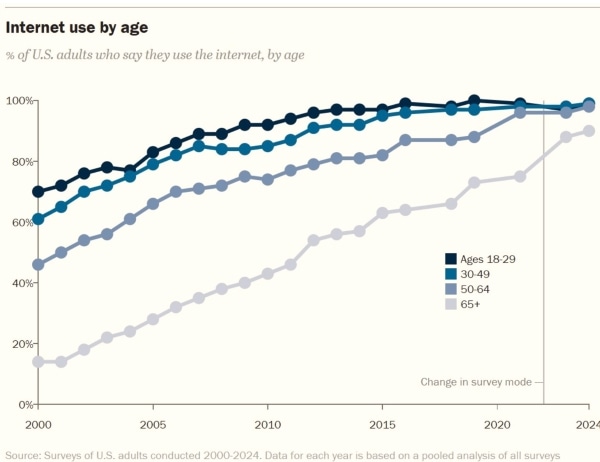How E-Commerce is Changing Retirement — For You and Your Parents

You may worry: what if Mom or Dad gets scammed trying to order a prescription online? Or that excessive complexity will frustrate them and prevent them from shopping digitally at all. In fact, those of us in our 40s and 50s often share the same concerns.
That fear is real — and it’s also a barrier we must address head-on. As e-commerce becomes increasingly essential in our daily lives and for independent living, embracing the benefits of online shopping while maintaining safety is crucial.
- Advertising Week reports that more than 85 million U.S. consumers over the age of 50 are now online buyers.
- In any given month, over 70% of U.S. adults 50+ make purchases online (often via smartphone) — very close to the usage rates of younger cohorts.
Senior Tech Adoption: The Landscape
Before exploring how e-commerce fits into our lives, including retirement, it’s important to understand the current state of technology among older adults.
- In a recent Pew survey, 90 percent of adults aged 65+ report using the internet.
- Earlier research showed that only around 75 percent of Americans aged 65 and above used the internet, revealing how rapidly adoption has grown.
- Still, usage is uneven: smartphone ownership declines sharply in later decades, and broadband access remains dependent on income and geography.
- To complete typical tasks on commerce sites, only about 55.3 percent of seniors succeed, compared to 75 percent of younger users.

These numbers tell me three things: many older adults are now online, but their tech experience is varied. Usability matters more than ever.
However, in the decades to come, those of us between the ages of 45 and 65, who are already accustomed to using and shopping on the internet, will continue to do so for shopping and entertainment.
Why E-Commerce Matters in Retirement
There are still some of us, including some older adults, who think, “Why not stick to the old way — drive to the store, shop in person?” Online retail is not just about convenience. It’s about dignity, safety, and access. For those who are older and have more limited mobility, shopping online offers the freedom and independence they once enjoyed.
Key advantages of shopping online:
- Reduced physical burden — no more loading carts, walking long aisles, or dealing with parking.
- Access to specialty goods — adaptive clothing, mobility aids, and medical supplies may not be locally stocked.
- Contactless delivery — especially important during illness outbreaks or for those with mobility limitations.
- Autonomy — an older adult placing orders themselves fosters independence rather than always relying on caregivers.
In retirement communities, including assisted living and nursing homes, that advantage is magnified: the community can adopt systems, tech support, and delivery strategies that benefit all residents.
Retirement Communities Leveraging Digital Retail
Some forward-thinking retirement communities are incorporating e-commerce features into their daily operations. These can include:
- Adapted user interfaces: larger buttons, high-contrast displays, voice commands. These features respond to vision, dexterity, and cognitive needs.
- In-house tech training or “digital ambassadors”: staff or resident volunteers assist others in learning to place orders, track deliveries, or manage accounts.
- Integration with health and pharmacy services: communities partner with pharmacies or medical supply vendors to facilitate reorders, telehealth services, or medication services via digital channels.
- Delivery management: offering scheduled delivery windows, drop-off lockers, or in-building parcel kiosks to reduce missed deliveries.
These steps reduce friction and give residents the confidence to shop online more often.
Where Seniors Spend Online
Here’s where older consumers tend to shop:
- Health and wellness: medications, supplements (where legal), incontinence supplies, home health equipment
- Groceries and meal kits
- Clothing and home goods
- Tech for communication: tablets, smartphones, assistive devices
I’d recommend that you periodically ask your parents what they buy and compare it with online prices, delivery options, or other factors to see if they would improve their quality of life. You may be surprised how they have already learned shopping secrets online, just like they did when they were shopping at the malls in the 80s.
Risks and Barriers You Should Know
Even the best interface doesn’t erase all obstacles. Here’s what still holds many seniors back — and how you, their child, or their community can help.
| Barrier | Why It Matters | What You/They Can Do |
| Digital literacy or lack of confidence | Older adults may fear making a mistake, entering wrong info, or breaking something. | Provide hands-on training, pair with trusted helpers, set up dummy orders first. |
| Security, privacy, and scams | Older people are prime targets for phishing, fake sites, or identity theft. | Use well-known retailers, enable two-factor authentication, use credit not debit, monitor accounts. |
| Site usability issues | Complex menus, small fonts, confusing checkout flows derail purchases. | Look for "senior-friendly" sites; demand accessibility improvements from vendors. |
| Delivery failures | Missed delivery, wrong address, inability to lift packages. | Use delivery windows, require signatures or indoor delivery, use building drop lockers. |
| Cost and logistics | Shipping fees, delays, returns can discourage use. | Bundle offers, use free-shipping thresholds, plan ahead. |
What You and Your Parent Can Do Today
Before you or your parent dives into online shopping, it helps to start with a plan. Some older adults find e-commerce intimidating at first — and many adult children aren’t sure how to guide them safely.
By taking a few simple steps together, you can lower the risk of scams, build confidence, and make each purchase a positive experience. These practical actions provide a roadmap to introduce online shopping gradually, allowing your parent to gain independence while you maintain peace of mind.
- Start small — practice placing a low-risk order together (a small item).
- Choose trusted vendors — big-name sites or local pharmacies reduce the risk of scams.
- Set up tracking / alerts — many services offer “delivery notifications” via email or app.
- Enable and explain security features, such as two-factor authentication and account change alerts.
- Encourage community learning — your parents’ retirement community or local library may run workshops.
- Give feedback to vendors — older customers deserve easier, safer interfaces.
Tracking Your Order
After you’ve clicked “place order,” the next question is almost always, “When will it get here?” Whether you’re ordering for yourself or sending a gift to a friend or loved one, tracking deliveries has never been easier or more reassuring.
Most major retailers now provide real-time shipment updates via email, text, or app notifications, allowing you to see when a package leaves the warehouse, reaches your local hub, or is on the delivery truck.
For example, with the Packy service, you or a loved one can enter a tracking number and track parcels from over 800 carriers worldwide. Thanks to the convenient platform, you can track your deliveries from international marketplaces and know exactly where your order is at any given moment. You will discover whether it has already crossed the border, is en route, or is possibly already being transferred to the local delivery service.
Many carriers also offer customizable alerts so you can choose a delivery window, reroute a package, or authorize someone else to sign for it. Retirement communities and apartment buildings are increasingly adding parcel lockers or concierge desks where packages can be scanned in and tracked until you’re ready to pick them up.
For older adults, this level of transparency removes much of the guesswork — and anxiety — from online shopping, making it easier to plan your day and ensure your purchase arrives safely.
Researching Long-Term Care Online
Shopping for groceries or clothing isn’t the only way e-commerce is transforming retirement life. Today, you can also research and plan for long-term care entirely online — saving time, reducing stress, and gaining access to expert resources you once had to hunt down in person.
The LTC News Caregiver Directory offers the largest database of in-home caregivers, assisted living facilities, and nursing homes in the United States. With a few clicks, you can compare providers by zip code, read reviews, and check the services they offer. You and your loved one will have a clear understanding of costs, staffing levels, and amenities before making a phone call or scheduling a visit.
LTC News also surveys the cost of all types of long-term care services. The cost of care calculator will show you the cost of extended care services where you or a loved one lives and the projected future cost for that care: Find Cost of Long-Term Care Services Where You Live.
Learning about Long-Term Care Insurance is also easy online. Just as necessary, you can now reach licensed Long-Term Care Insurance specialists online. These specialists work with multiple top-rated insurance carriers to find the best coverage for your age, health, and financial goals.
The vetted specialists who partner with LTC News are independent, highly experienced professionals dedicated to long-term care planning. Many hold the Certified in Long-Term Care (CLTC) designation — the industry’s most recognized credential — and are endorsed by the American Association for Long-Term Care Insurance (AALTCI). Several are also Ramsey Trusted Pros, recommended by Dave Ramsey’s organization for their integrity and expertise. In addition, some maintain strong ties with Christian and Jewish community groups, underscoring their commitment to ethical service and values-based guidance.
Get Accurate Quotes from Trusted Long-Term Care Insurance Specialists
Shopping online makes it easier to compare benefits, inflation protection options, and underwriting requirements side by side. It also helps you secure the lowest available premiums because specialists can check the full market at once rather than pushing a single company’s policy.
This online access empowers you to plan ahead rather than scramble during a crisis. Whether you’re exploring caregiver options for an aging parent or evaluating your own future needs, starting with an online search gives you a head start on making confident, informed decisions.
If you are a Long-Term Care Insurance specialist seeking to get vetted, please contact us at LTC News.
What’s Next: The Future of Senior E-Commerce
E-commerce for older adults isn’t standing still. As technology evolves, so do the tools, services, and protections available to you and your loved ones. Understanding where the market is heading helps you make better choices today and prepare your parent—or yourself—for tomorrow’s digital landscape.
These upcoming trends show how senior-friendly shopping will become even more seamless, secure, and supportive in the years ahead.
- AI and voice assistants tailored for older users (lower jargon, more empathy)
- Deeper integration of health, pharmacy, and medical devices into shopping platforms
- Subsidized or publicly funded digital literacy programs built specifically for retirees
- Stronger regulation and scam protections for vulnerable populations
Several services are available to offer assistance to older adults. Mid-Serv Solutions is a concierge service for seniors that handles shopping and delivery. It also helps with paperwork and communication. One Senior Place is an information resource and service that helps older adults navigate online services, delivery, and ordering.
Final Word
You and your aging parent are in the middle of a quiet digital shift. E-commerce is no longer a fringe convenience — it’s a practical tool for safety, access, and dignity in later life.
As you help bridge the gap, you’re not just helping them shop — you’re helping maintain independence, choice, and confidence. The more we design for this generation’s needs, the more inclusive the future can be for all of us.


